Q: Is there really a Florida-Friendly Landscaping™ law that allows homeowners to remove their turfgrass and install Florida-Friendly Landscaping without HOA permission?
A: Not exactly… It’s a little more complicated.

Back in 2009, Florida Statute was modified to say that HOA rules “[…] may not prohibit or be enforced so as to prohibit any property owner from implementing Florida-Friendly Landscaping, as defined in s. 373.185, […]”* [Ref.]
People will sometimes quote that particular line as “proof” that you can re-do your landscape without seeking permission, and your HOA can’t stop you…
However,… an HOA’s architectural review board is still often allowed to determine whether proposed landscaping modifications will fit within the aesthetic style of the community (provided that’s the process specified in the deed restrictions). Therefore, while the HOA can’t outright prohibit someone from applying Florida-Friendly Landscaping™ principles, any proposed landscape modifications could still potentially be required to receive HOA board approval, and could potentially be required to meet certain aesthetic guidelines for design & maintenance (depending on the specifics in the deed restrictions).
Likewise, even if you don’t live within a deed-restricted community, your local government may have certain rules or codes about standards of property upkeep that must be met in order to avoid code enforcement actions, etc.
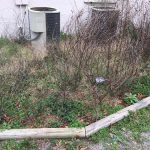
In short, the FFL law does not completely undo the architectural review process. An HOA still has the ability to decide whether a landscape modification fits within the community’s overall design.
Likewise, allowing weeds and/or wildflowers to take over a yard and calling it “Florida-Friendly” could potentially still result in penalties or enforcement action, depending on the specific wording of your community’s rules.
(For example, the outcome of one recent case largely depended on subtle details like the specific definition, or lack thereof, of the word “weeds.”)
On the other hand, an HOA board could potentially be challenged if they are requiring landscape aesthetics that cannot reasonably be achieved by adhering to your local watering restrictions, or by following the 9 Principles of Florida-Friendly Landscaping™. For example, if they require a homeowner to maintain an impossibly lush, green lawn, even when conditions are not suitable (dense shade, severe drought, winter dormancy, soil constraints, nematodes, etc.) and they’re demanding that the homeowner use excessive amounts of irrigation, fertilizer, re-sodding, etc. to achieve that unrealistic aesthetic… that could potentially be in conflict with the intent of the FFL law.
DISCLAIMER:
I want to be 100% clear. I am not a lawyer, and this blog post is not intended to substitute for legal advice. My main goal is to help highlight some of the ambiguous “grey areas,” and to counteract some of the questionable statements that seem to circulate on social media whenever HOAs and “the FFL law” get discussed… I’m hoping you’ll gain an understanding that these issues can get hazy, complicated, and potentially costly… so whenever possible, it’s better to avoid conflicts, find common ground, and prevent problems before they start.
(Also, just a general life-tip: Don’t believe all the “legal advice” you read in the Facebook comments section…)
Working smarter, not harder…
With all that in mind, here are a few tips & strategies to help avoid conflicts between homeowners and communities when making modifications to the landscape:
Find some common ground…
Maybe everyone can agree that half-dead turfgrass is a bad look…
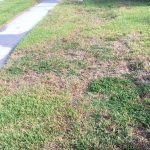
Everyone can probably also agree that algae-filled ponds look gross. Plus, they cost a lot to maintain…
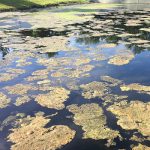
And everybody wants the community to look good, right?
And it would be great to save everybody some money on pond maintenance, right?
Talking-point tip:
Did you know? – Pond and landscape maintenance are often among the largest annual budget expenses for HOAs. But many people don’t realize that there’s a direct connection between their ponds’ excessive algae growth and the excessive irrigation and fertilizer being applied throughout the community… So, when talking to the HOA board about your landscape goals, rather than focus entirely on helping birds & pollinators, try connecting about wanting to help the community look good, clean up the ponds, & save some serious $$$$!
Talking-point tip #2:
Nearly everybody is familiar with the concept of a “square peg in a round hole.” It’s an analogy about stubbornly trying to make something fit where it doesn’t belong.

The “square peg” analogy can be a great way to help people understand the idea behind Florida-Friendly Landscaping. Why should you stubbornly struggle to force a plant to grow where it clearly doesn’t want to grow? There are plenty of attractive plants that are well-matched to those site conditions, and would LOVE to grow in that exact spot. Right plant, right place. Round peg, round hole. Work smarter, not harder.
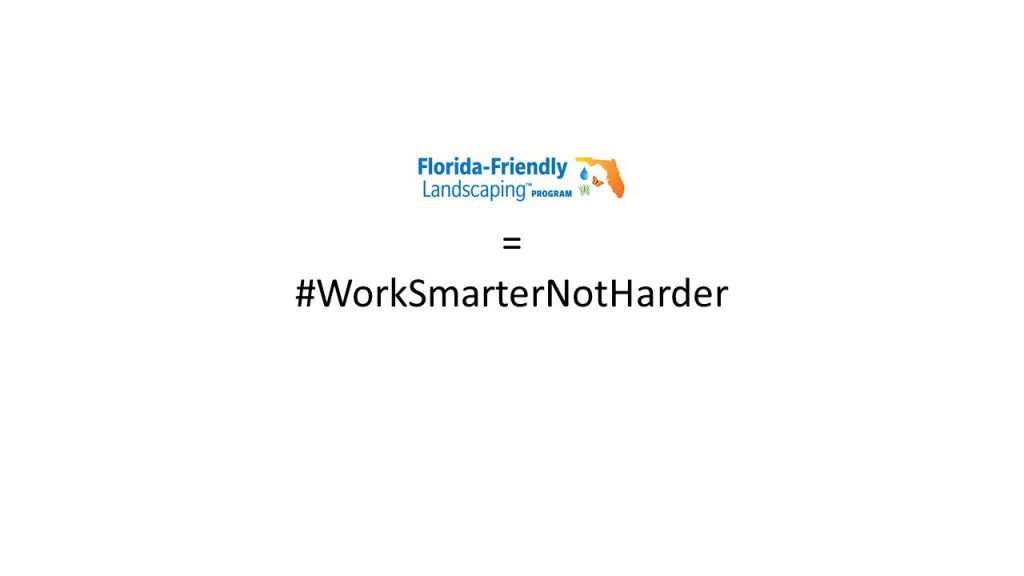
Perfect. Now that you’ve got a couple of starting points of agreement…
A picture’s worth a thousand words…
Remember, even after you’ve explained about “right plant, right place,” etc., as soon as you say “I want to convert my turfgrass to Florida-Friendly Landscaping / drought-tolerant plants,” it’s an opportunity for imaginations to quickly run wild…
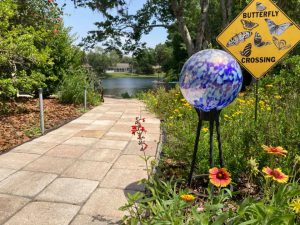
(Image shows a portion of the beautiful award-winning landscape from the 2020 Water-Wise Awards.)

…In other words, the term “Florida-Friendly Landscaping” can invoke a lot of different ideas to different people.
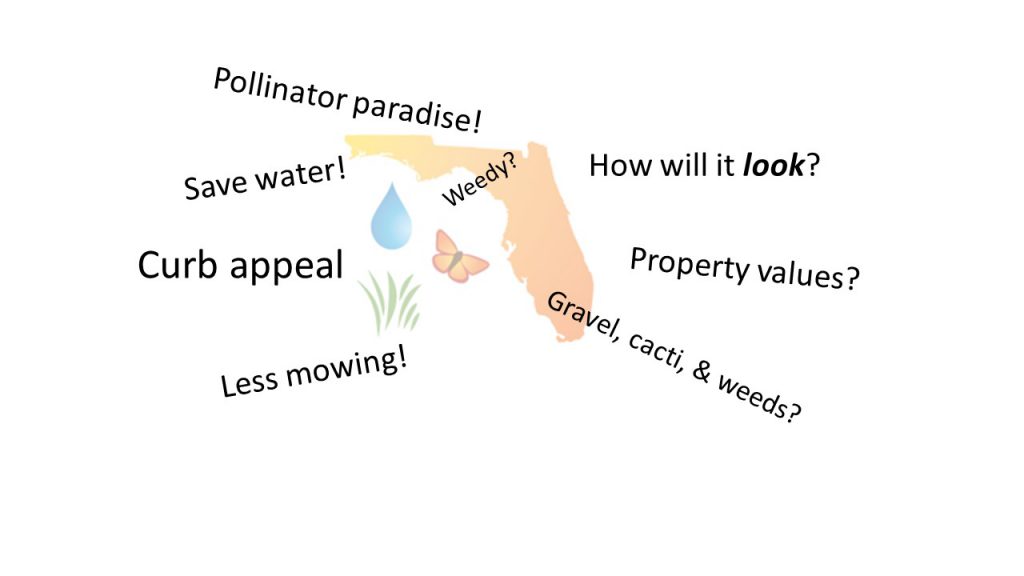
If you’re envisioning a vibrant oasis of site-appropriate native shrubs, ornamental grasses, groundcovers, and blooming flowers, make sure they’re seeing it too!


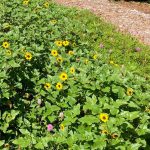



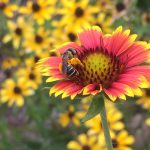

TIP: You’ve probably already gone through the work of researching plants and developing a conceptual site plan, so it only takes a little extra time to gather a few photos to help share your vision for the space. Offer some reassurances that you’ve got a plan, and it’s going to look good.
[NOTE: If you haven’t done your homework yet, do that BEFORE going to the board! Particularly if you’re potentially trying to reference “the FFL law,” you’ll want to be ready to justify why your proposed modifications would better fulfill the Florida-Friendly Landscaping principles (i.e. matching “right-plant, right place,” etc.) than your current landscape does.]
If we approve this… what next?
One of the big concerns we often hear from members of HOA boards is this – If we approve a specific Florida-Friendly Landscaping change for one yard (such as expanding a landscape bed), do we risk our ability to maintain some “quality control” and say “no” to other, more extreme modifications?
In other words, they’re not necessarily opposed to allowing FFL modifications that “fit” with the community’s style, but they don’t want to simply “open the floodgates” and end up with total chaos. Likewise, they may be concerned that they’ll be accused of arbitrarily or inconsistently applying the rules if they say “yes” to your proposed changes, but “no” to your neighbor…
So… how exactly does an HOA maintain the ability to accept one type of modification, but still reject more extreme changes, such as all-gravel “xeriscaped**” yards?
Put it in the rules.
The Florida-Friendly Landscaping Program has developed an excellent set of tools specifically to help you and your HOA incorporate Florida-Friendly Landscaping language directly into the CCRs, and to facilitate better communication & cooperation between homeowners & the HOA.
- See: Florida-Friendly Landscaping™ Model Covenants, Conditions and Restrictions
- See: ARB considerations for FFL guidelines for architectural review boards
The thing to remember is that Florida-Friendly Landscaping™ (FFL) isn’t a single look or style. It’s all about matching the right plant with the right place, and providing the right care at the right time.
Every community is unique. Landscape conditions vary. Well-designed Florida-Friendly Landscapes can look vibrant and attractive, while using less water, fertilizer, and pesticides. Anyone can apply the 9 Principles of Florida-Friendly Landscaping in a way that fits their community’s aesthetics and landscape goals.
(**Side-note – The word “xeriscaped” was in one of the original versions of the FFL law, but was actually removed from the final language. The reason? Xeriscaping and FFL are actually very different concepts designed for very different climates. Because Xeriscape was developed for arid climates that receive minimal rainfall, it is generally inappropriate for our unique Florida climate, which can include extreme wet or dry conditions. Therefore, Florida-Friendly Landscaping™ was designed to emphasize sustainable landscape practices such as adaptable, site-appropriate plants, stormwater filtration, and protection of water quality, as well as water conservation.)
For additional helpful resources, including ready-to-use templates for writing a Florida-Friendly landscape maintenance contract, check out the FFL “Community Association Kit.”
Learn more about matching “right plant, right place,” in my previous post. I’ve included links to a few helpful online plant selection tools that provide users various search filters (i.e. plant size, soil conditions, location, etc.) to find the perfect plants for any landscape!
TIP: Remember – Your local FFL Program Coordinators can also be a helpful resource! We will happily provide educational programs for the HOA board and community members so that everyone understands exactly what is and isn’t considered “Florida-Friendly,” how to select the “right plant, right place,” etc.
TIP: Set REALISTIC expectations! Florida-Friendly Landscaping doesn’t equal “no-maintenance!” Florida-Friendly Landscapes are still going to be maintained, although the type and balance of maintenance activities may shift somewhat. Every landscape will be different, but the largest benefits & savings are frequently from the reduced need for irrigation, fertilizer, pesticides, etc. There are often tradeoffs of increased weeding, especially when the new landscape areas are getting established.
Click to read about a comparison of maintenance and water usage in “traditional” landscapes vs. FFL.
Check out a great webinar about natural and non-chemical weed control – HERE.
The information in the above blog post was compiled and adapted from the following helpful FFL resources:
- Florida-Friendly Landscaping FAQs – Find answers to the most common FFL-related questions, including: Is Florida-Friendly Landscaping the same as “Xeriscaping?” Is turfgrass Florida-Friendly? …etc.
- Florida-Friendly Communities – a collection of numerous community-focused FFL resources, including many referenced in this post
- Florida-Friendly Landscaping – Model CCRs / Deed Restrictions – Ready-to-use template to help incorporate FFL language into your community’s CCRs
- Ten Strategies for Working With Your HOA to Convert to a Florida-Friendly Yard– Tips for working together and avoiding conflict
*Other references:
TC Palm – Judge rules PSL homeowner’s “high grass and weeds” are Florida-friendly flowers
Created an attractive Florida-Friendly Landscape in your community? Consider submitting an entry to the annual Water-Wise Awards competition!
About UF/IFAS Extension: UF/IFAS Extension serves as a source of non-biased, research-based information for the residents, businesses, and communities of Florida, providing educational materials and programs for adults and youth. We proudly bring UF to you.
(Not in Pasco County? Not a problem! Click here to find your local UF/IFAS Extension office!)
By Frank Galdo
About the Author
As one of the Florida-Friendly Landscaping (FFL) Program Coordinators in Pasco County, I enjoy helping people create & maintain vibrant landscapes that DON’T require a lot of water, fertilizer, and pesticides to look their best. Through an innovative collaboration with Pasco County Utilities, I also provide targeted on-site troubleshooting outreach to help those individuals and communities identified as high water users. My motto is – “Less guesswork, better landscapes.” I can be reached at fgaldo@ufl.edu
Thirsty for more FFL knowledge? Don’t forget to follow us on Facebook & Twitter!
Have a question, or an idea for a future post? Let me know at fgaldo@ufl.edu or leave a comment below.
UF/IFAS Extension Is An Equal Opportunity Institution.
 1
1

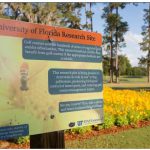


Comments:
September 27, 2021
Thanks for the info!
September 27, 2021
Hi Kay, thanks for checking out the blog! A border can potentially be helpful in some situations. A good solution for a slight slope can sometimes include using a border in combination with a mulch like pine straw, which tends to "knit" together. Another trick that can help is to create a slight "dip" behind the border by removing a bit of the soil back there. It doesn't necessarily need to be a major trench. Just a slightly lower area... (Side-note- Pine straw has recently been difficult to source in some areas. Hopefully, dry fall weather will be more favorable for baling, and the supplies will rebound.) It's difficult to make a blanket statement though, because each situation can be different... Often, your ability to keep the mulch in place using the various solutions mentioned above will depend on a combination of both the slope, and also the volume of water that's pooling or flowing through the area. For example, if a downspout causes a LOT of water to flow through at a high rate, that can definitely increase the concerns for washout, etc. One thing especially important to keep in mind is that if the area has standing water during any of our wettest summer rainy periods, certain types of mulch (i.e. pine bark nuggets) might go floating down the road... Feel free to send me some photos by email if you'd like some additional brainstorming of solutions - or if you'd like to show some before/after success stories. Those are always great too! Hope that helps. Happy gardening!
September 25, 2021
If the mulched area is sloped (slightly) towards the street, can a border keep it where I want it? Or will it become another high-maintenance project?
September 8, 2021
Hi Ken, thanks for checking out the blog! Due to the difficulty in tracing the origins of the cypress trees used for production of mulch, the Florida-Friendly Landscaping Program encourages alternatives such as melaleuca, eucalyptus, pine bark, pine straw, etc. They are effective mulches which offer better assurances of sustainability. Each has some pros and cons, as outlined in the post above. If you're converting large areas, it can sometimes be beneficial to solarize the ground prior to planting, or use some other method to address the dormant seed bank. Otherwise, weeds can definitely become problematic, even with a decent layer of mulch. Dr. Chris Marble did a great webinar a few months back discussing a variety of good weed control strategies. The link for the recording is: https://mediasite.video.ufl.edu/Mediasite/Play/0de38b692fb44892be423cdde3d310581d If you'd like some advice for any specific sites you're working with, please feel free to get in touch with us. We're happy to follow up by phone or email. Hope that helps!
September 8, 2021
We are removing a lot of the grass in our yard and replacing it with Florida friendly plants. Is there a mulch you would recommend. Our landscaper recommends Cyprus but with the ecological damage that we are causing from removing Cyprus trees I am concerned about this.
September 6, 2021
Really enjoyed this post.Really looking forward to read more. Will read on
August 10, 2021
Really informative post.Thanks Again. Cool.
August 9, 2021
I love your sense of humor along with the great gardening content!
August 3, 2021
Hi Mohammed, thanks for checking out the blog, and for that interesting bit of information - I learned something new today!
August 3, 2021
This is a good one and it fools many people. Black disc is a term used to describe the appearance of deteriorated spinal discs on medical imaging studies.
July 17, 2021
I discovered the frog fruit and purslane in our front yard, so thrilled to have it growing wild in our yard, the pollinators love it!
June 21, 2021
Great article. I especially like the questions that make me think about whether I've used something and why I'm still keeping it! Thanks for sharing.
March 18, 2021
Hi Rick Have you looked up the upcoming events for Pasco County Extension on our website? The calendar of events can be seen here: http://sfyl.ifas.ufl.edu/pasco/?topic=work-and-life#county-feed There isn't an upcoming canning class in Pasco scheduled at this time, but some Florida counties and other Extension schools are doing virtual classes. You can find those on Event Brite: https://www.eventbrite.com/d/online/canning/?page=1 Hope this helps :) Our office number is 352-518-0156
March 17, 2021
am looking for canning class, and garden class and other phone number for ex service
March 12, 2021
Hi Carolyn The biggest thing to remember is if the food requires temperature control/refrigeration for safety. Under cottage food law, the food cannot be a TCS food (time and temperature control for safety). A cheesecake would not be allowed, but bread products that can be left out at room temperature may. See this literature from FDACS for more info: https://www.fdacs.gov/content/download/70108/file/Cottage-Food-Operations.pdf You can also email me if you have any additional questions: sbresin@ufl.edu
March 11, 2021
I live in Hudson, FL. I am trying to find what I can and can't bake to sell from home. Please help me. Thank you.
February 15, 2021
Hi Chris, thanks for checking out the blog, and for the great question about invasive plants. Here's one way I like to think about it: The first FFL Principle, "right plant, right place" means that you should be matching your plant selections to your site conditions, and to the amount of available space. For example, if you have a 3' x 3' area next to your front door, you wouldn't want to plant a live oak there. It would obviously be the "wrong plant," because if it grew to it's maximum potential, it would cause significant maintenance costs, harm to your home's foundation, etc. So, any plant (native or not) that's destined to outgrow its available space and become a maintenance nightmare would be considered the "wrong plant" for that space, according to the FFL Principles. However, invasive plants take that concept further. By definition, invasive plants are those that have proven themselves to be unwilling and unable to be contained and maintained in the place they are planted. Likewise, they've proven themselves again and again to be 100% capable of becoming maintenance nightmares. They are known to escape cultivation, and when they do, they cause significant environmental and/or economic harm. They disrupt habitats, out-compete, smother, and displace native plants (and the wildlife that depend on them), many are toxic to wildlife and livestock, and they almost always cost significant amounts of money and labor for control and removal. (Furthermore, because many invasive plants are capable of being are spread long distances by water, wildlife, landscape equipment, etc., often the person who originally planted them is not the one bearing those costs - at least not directly - however, because management of invasive plants impacts the operations and budgets of many municipalities, parks, ranchers, farmers, etc., EVERYONE actually pays the costs to manage invasive species.) So I hope this answer helps you, and other blog readers, to see the connection - by their very nature, invasive plants can't meet the criteria for "right plant, right place!" If you're interested in learning more, be sure to follow @PascoExt on Facebook or Twitter. I'll be sharing lots of information, tips, and trivia for "Invasive Species Awareness Week" later in February! Sneak peek: Did you know? Some invasive plants actually make it much more difficult to manage Florida's fire-dependent habitats with prescribed burns, and can even allow natural wildfires to burn bigger, faster, and hotter than they otherwise would!
February 15, 2021
How does removing invasive plants fit into these principles?
February 4, 2021
Hi Steve - Thanks for checking out the blog! Regarding your questions about mulch depth and turning mulch, the answers will probably depend on a number of different factors (i.e. type of mulch, environmental conditions, aesthetic goals, etc.), so it's difficult to provide a good "one-size-fits-all" recommendation... The 3-4" recommendation comes from the fact that it's often a good functional balance between preventing weeds while still allowing water to percolate through. Mulching at less than 3" will tend to diminish the mulch's weed-blocking capabilities, while using more than 4" will often start to intercept too much rainfall, and can potentially even begin to affect gas exchange with the soil, etc... So it's about striking that balance. (Also, mulch costs money, so if you're working with a budget, and a 4" layer is effective, why spend extra $ for minimal benefit, right?) Regarding raking, here are a couple of factors to take into consideration - In some situations, there's no turning necessary - (particularly if leaves and pine needles are being used) - because the natural networks of soil microbes & decomposers do a great job of transforming these mulches into a rich layer of humus. So if using needles and/or leaves, you'd probably just want to spread more on top to replenish the mulch as it breaks down. In other situations, especially where wood or large-chunk bark mulches are used, there can sometimes be benefits to raking... BUT it's ultimately going to depend on the site conditions, etc. The primary reasons to turn or rake the mulch would be: 1) Some mulches are extremely slow to break down, so they may fade in color before they actually NEED to be replenished (from a functional standpoint). If your community's mulch is primarily being re-applied because it's lost its "pizazz," raking can potentially help revitalize and refresh the appearance of the mulch between re-applications. (That saves $ and prevents the mulch from piling up too excessively.) 2) Over time, certain mulches - especially wood-based mulches - can become very matted to the point where they begin repelling water. If the mulch is very matted, raking can help break up that "waterproof" surface layer, helping water penetrate again. 3) If the mulch has spread from where it was originally applied, and is now encroaching on plants, walkways, etc. it may need to be rearranged back where it belongs. So long story short, consider the mulch's function, looks, and costs, and let those factors determine the correct approach. I hope that helps. Feel free to follow up with me by phone or email if you'd like to dive into specifics for your community's landscaping. fgaldo@ufl.edu or 727.514.5488
February 4, 2021
Thank you Frank. Our HOA mulches every year but the mulch is never turned and seems too thick in many areas. I'd like to share with the board of directors, your recommendations on turning mulch, frequency, time of year, pros vs cons, etc. I see you recommend 3 to 4 inches in thickness, how much is too much and why? Thank you very much.
September 10, 2020
Hi Robin - Welcome to Florida! Sorry to hear about your hibiscus troubles. Unfortunately, many hibiscus plants are prone to attracting piercing/sucking insect pests like mealybugs, aphids, & whiteflies. In general, the earlier you notice the issue, the easier it is to treat, so regular scouting is really important in order to grow hibiscus successfully. Another thing that can be helpful is to work on building up your population of beneficial insects. For tips on that, check out my recent webinar here - https://bit.ly/GardenPests-vs-GoodBugs_2020 For some additional info about growing hibiscus & managing their pests, check out - https://gardeningsolutions.ifas.ufl.edu/plants/ornamentals/hibiscus.html
September 5, 2020
Oops. Same comment without my typos: I’m new to Florida and I believe they were aphids that overtook my hibiscus. Tiny white bugs that looked like a small white line, followed by the sooty mold BUT then horrible fur that looked like brown mice on my plant! Before the fur arrived I tried unsuccessfully to treat it with a mild organic spray and then I threw the plant out but wondering what it was so I don’t get it again.
August 28, 2020
Hi, Thanks for checking out the blog! I appreciate your feedback & completely agree. It would have been great to show that step, and that was my initial plan. Unfortunately, I didn't have a tripod or stand available for the camera, and I was shooting the video solo... I wasn't able to spread the roots effectively while simultaneously filming. If I manage to film it next time, I'll be sure to update the post! Thanks again for checking it out - Happy gardening!
August 28, 2020
Need video on setting disturbed root ball into new hole to ensure no voids around roots. Previous video left a flat bottomed hole and a promise of video of released roots.
August 24, 2020
Hi Rebeca - Thanks for checking out the blog, and sorry to hear about your struggles with aphids. Summertime in FL can be a tricky time to grow veggies. Heat, humidity, insects, and disease can challenge even the best of us. This summer has been particularly brutal in terms of heat stress. However, there are always a couple of things that we can do as gardeners to tip the scales in our favor. 1) During summer, limit your crops to those that are well-adapted to hot, semi-tropical conditions. Sweet potatoes, roselle, Asian longbeans, okra, etc. Other veggies such as greens, broccoli, cabbages, etc. should be saved for the fall & winter gardens. 2) Check for signs of root nematodes, which can be a major cause of stressed plants in summer veggie gardens. These microscopic worms harm your plants' roots, making them unable to effectively take up water and nutrients. Plants affected by nematodes look stunted & wilted, and are more susceptible to attacks by aphids & mealybugs. (Okra is especially vulnerable to nematodes, so if you've got tiny, stunted, struggling okra, it's a good reason to check for nematode issues.) For more about nematodes, check out this post: https://blogs.ifas.ufl.edu/pascoco/2018/05/22/you-might-have-worms/ 3) Make sure your garden is attracting & supporting lots of beneficial insects. Including a lot of pollinator-attracting flowers will help draw in the "good bugs" - lacewings, hoverflies, parasitic wasps, etc. For more about that, check out this recording of a recent webinar - https://youtu.be/fyKodxQmH3M or for a quick summary, you can take a look at this blog post - https://blogs.ifas.ufl.edu/pascoco/2019/10/16/how-do-i-attract-the-good-bugs/ 4) Check for ants "farming" the aphids. Sometimes, fireants will protect the aphids in exchange for the aphids' sugary excretions. The ants will often have a nest at the base of the plant, and they will actually protect the aphids from the beneficial predator insects. This happened on some of the Asian longbean plants at the community garden this year. Once you get the ants under control, the beneficial insects can often restore balance. Anyway, hope that helps. Don't give up!
August 21, 2020
First year doing an entire edible garden and aphids seem to have taken out two entire raised beds full of plants, before fruiting could even begin. I've tried dish soap and water, many Bonide organic products, water. You name it. Nothing keeps them off or kills them. If anything it stresses my plants out more than the aphids. Is this a more common issue in summer? I read that they thrive in cooler temps. Im just trying to figure out if I should even bother planting my fall garden. The only things they haven't destroyed are plants in containers. Tomatoes and jalapeños. Thank you in advance for your help.
July 27, 2020
Hi Rick The commercial kitchen in Dade City, where I would normally hold the class, can't have more than 2 people in it at this time. I hope to offer this again as soon as it's safe to do so :) In the meantime, check out the USDA's Complete Guide to Home Canning: https://nchfp.uga.edu/publications/publications_usda.html Let me know if you have any questions: sbresin@ufl.edu
July 26, 2020
looking for a class in canning no rush
July 20, 2020
Hi Pam, thanks for checking out the blog! I don't know that anyone at UF has done any official research on best storage practices for bagged mulch. However, here are a couple of general tips and things to consider - 1) Bags will likely be degraded by the UV in sunlight, so to avoid a bag blowout when you eventually try to move it, try to keep it covered, or someplace shaded. 2) The longer it sits, the more it will break down. Moisture will speed up the decomposition of the mulch. The wetter it is, the faster it will break down. Eventually, it could end up somewhere between mulch and compost. 3) Over time, you may see white mycelium* growing in the mulch, unless it is really, really dry. That’s perfectly normal & still safe for using around your plants. (*Think of mycelium as a bit like the "root system" for the beneficial fungi that help decompose leaf litter and dead wood - a bit of an oversimplified comparison, but that's the basic idea...) 4) Keeping it up off the ground (i.e put on pallet, etc.), might help reduce ants and other critters. Hope that helps!
July 18, 2020
I purchased bagged melaleuca mulch. What is the best way to store my extra bags?
July 13, 2020
Hi Adele, thanks for checking out the blog and sharing your experience with purslane! Really interesting to hear about its positive response to a controlled burn. In response to your question about whether I've published any books about native plants and sustainability - no, BUT... there are some really excellent books available through the University of Florida Press. Here's a direct link to the "Gardening" topic section - LINK: https://upf.com/subjresults.asp?expres=equals&subj=29&index=0 On the topic of Florida native plants, gardening, and sustainability, authors such as Craig Huegel, Ginny Stibolt, and others have written some wonderful how-to guides, available through the UF Press link above. Hope that helps!
July 11, 2020
I can give you some more info on this plant, we did a prescribed burn on our property and now have a 20 x 20 space we cleared for an in ground garden, I have had a over abundance of the purslane in pink and purple come up since the burn, I left if as ground cover as the pollinators love it, I walk all over it, drag hose across it and move it out of the way to weed around it, in my experience it just seems to thrive and continues to reseed easily, it has made a huge difference in the garden..also have you published any books on florida native plants and sustainability??
June 15, 2020
Hi Carlee – Thanks for checking out the blog. Sorry to hear about your struggles with pests. Sometimes, even when we’ve taken steps to provide good habitat and food sources for beneficial insects, the pest pressure can ramp up faster than the beneficials. Particularly, this can become a problem if you have young plants with plenty of new, tender growth, or your plants are stressed by environmental conditions (like the recent extreme springtime dry season). Sometimes, additional steps are called for until “the cavalry” can arrive... If you can get a few clear, well-focused photos, I’d be happy to take a look at the specific pests you’re dealing with. That way I’ll be able to make the best recommendations to help your plants. (A tip to get really clear, close-up photos – Sometimes cameras have a difficult time focusing on a small, thin object like a leaf or a plant stem. Hold a flat object (a book, your hand, a piece of paper, etc.) near the leaf or branch you’re trying to photograph. First, lock your camera’s focus onto the flat surface, then take the photo of the pests.) Without photos, the general recommendation would be to apply a low-toxicity product containing neem oil, or a horticultural soap, as described in the following publication: https://edis.ifas.ufl.edu/pdffiles/IN/IN19700.pdf Just remember to always read labels carefully, follow all instructions closely, and pay attention to any temperature precautions listed.
June 13, 2020
We have a FL natives yard. Aphids are on the growing tips of our Slash Pine, Fire Bush, and Coco Plums. I see no evidence of beneficial predators though we have plenty of nectar plants, tuck seed, rosin weed, FL green eyes, twin flower and salvias and spider wort. What are we missing? Help!!
May 18, 2020
Hi Gia, thanks for checking out the blog! I've moved to a new home since the writing of this post, , so unfortunately, I can't provide an update on the purslane patch. We only moved a few miles away from the old house, but the landscape conditions are VERY different - it actually gets soggy in the summertime! New challenges, new opportunities... To answer your question - the purslane in the photos was planted along the edge of a pollinator garden I'd built, so they weren't really getting walked on... Therefore, the photos really show how it can look when densely planted, without being regularly trampled. That said, there were plenty of other purslane plants scattered around the yard, and they seemed to survive occasional foot traffic just fine. I'm just not sure if you'd achieve the same full, "fluffy" growth as in the photos, but it will likely stick around, once established... Next to a driveway, there's likely a bigger issue to consider though... The purslane tends to die back in the winter, and re-appear in the springtime. That worked ok in my pollinator garden, where I had a constant rotation of things in bloom to provide interest, but if you're thinking of using it along the edge of the driveway, I could potentially foresee two issues - 1) sand/soil erosion from bare ground; and/or 2) HOA complaints due to those winter bare spots. One possibility to deal with the winter dormancy issue... you might consider inter-mixing purslane with one or more other creeping groundcovers such as Phyla nodiflora. That way, there's always something green for appearance, and to help hold the soil in place.
May 16, 2020
I see that you wrote this article nearly 2 years ago. I have been repotting some of the multitude of volunteers in my yard with the intent of placing in a "bad area" next to my driveway. In 're-searching' (googling mostly), many articles say it doesn't tolerate being stepped on, but I have quite a bit throughout the backyard and the kids play and run around, but it is not in one big patch, just here and there. I am curious to know if you still have this patch and if it holds up to being walked on. Thanks for the article!
January 26, 2020
Hi - would you please tell me if we need to rinse out the eggshells before tossing them in our composting bin? We haven't been including eggshells at all in it, but friends told us we can. Thanks!
December 22, 2019
I did absolutely the same. I found these pretty weeds on my lawns and saved them before my gardener mow them away. I planted them under a frangipani tree as ground cover. I wanted to know the name of this plant and found your blog - thank you. "kiss me quick flower" such a cute name. Gold Coast Australia
November 19, 2019
Where can I buy eculyptus mulch in nugget form? Anyone? I live in Delray Beach Florida
November 5, 2019
Hi, thank you for checking out the blog, and for your question. There can be a number of factors that potentially could be affecting your persimmon tree. We'll need a bit more background info to help narrow down the possibilities, so I'll follow up by email.
November 5, 2019
Can someone tell me why my Persimmon tree is not bearing fruit? It barely grow has few leaves despite all the care i gave. Do you think the roots are affected by root pests ? Any advised will be appreciated.
October 28, 2019
I enjoyed the article and details of your relocated "rescued" portulaca. Similarly, I have "rescued" these charmers from many places on our property in Kissimmee and transplanted them in planter pots that decorate our back patio. I'm glad to know that someone else has such an interest in the maintenance of this plant.
September 27, 2019
Love this plant.......almost as much as the pollinators. What an interesting looking bloom. Yes, it spreads like crazy, but as you said, find the right place for them and you will be rewarded. I'm in an HOA, and it just adds so much to the yard (along with my other natives, and less turf all the time). Got it at the Nature Coast Native Plant sale a few years ago. Which by the way is coming up in October.
July 23, 2019
Great principles!
July 19, 2019
Thanks for the tips regarding this. Your reader will surely appreciate what you've shared with us. Congratulations!
October 11, 2018
Hi there, Thanks for your comment! I just sent you a message at the email you provided below your name. If you don't see it, please message me: sbresin@ufl.edu
October 10, 2018
I am wondering if you will be offering these classes again. I have just found this, but the dates are already past. I live in Pinellas county, but would gladly drive to Pasco for a class.
May 15, 2017
Good to hear! Glad to help!
Comments are closed.